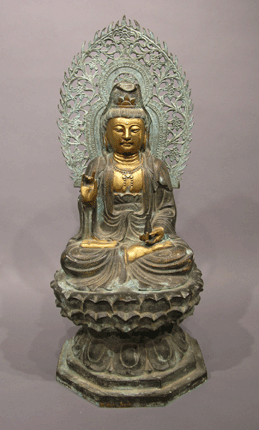
19th Century; gilding; Hunan. 29″h, 12″w
This antique bronze Kuanyin is seated in padmasana (lotus position), on a lavish tiered lotus throne, clasping a tiny bottle for water of life in her left hand, and the right hand raised in vitarkamudra (the gesture of giving instruction to believers). When the hand is raised with the thumb and forefinger in the action of pressing together, it symbolizes wisdom and compassion, while the other three raised fingers represent the triratna: The Buddha, The Dharma, and The Sangha. With this mudra (hand position), the Kuanyin is offering believers her help.
This Kuanyin exudes an air of serenity and divine majesty. Her gilded face has a “bindi” on her forehead (spiritually means to reach supreme goal of self-realization). Her hair is drawn up high into a bun, which at places shows a blue tint against the coppery hair due to oxidation of an alloy in the metal. She is wearing a lavish dark coppery hooded robe with incised floral designs, which covers the high bun on her head and cascades down in crisp folds around her body, falling open to reveal the upper part of her bejeweled gilded bronze chest.
A bronze areola of flame, a mandala (means “a ring of fire”) is attached to the figure’s back but can be detached. Fire in Tantrism means knowledge. Without knowledge there is no possibility of arriving at self-realization. The mandala has oxidized to a blue tint from aging.
This Kuanyin has an unblemished gilded visage, upper chest, exposed hands and feet. This is because these parts are made of brass, which has alloys of copper and zinc and shows a golden color, whereas the dark coppery parts are of bronze, with a high concentration of copper and a small amount of tin. The zinc has an oxide that flakes off, so surrounding base metal gets coated with it and with passage of time, causes oxidation and “rust”. The mandala, as well as the lotus throne the figurine sits on, turned a bluish color due to this process.